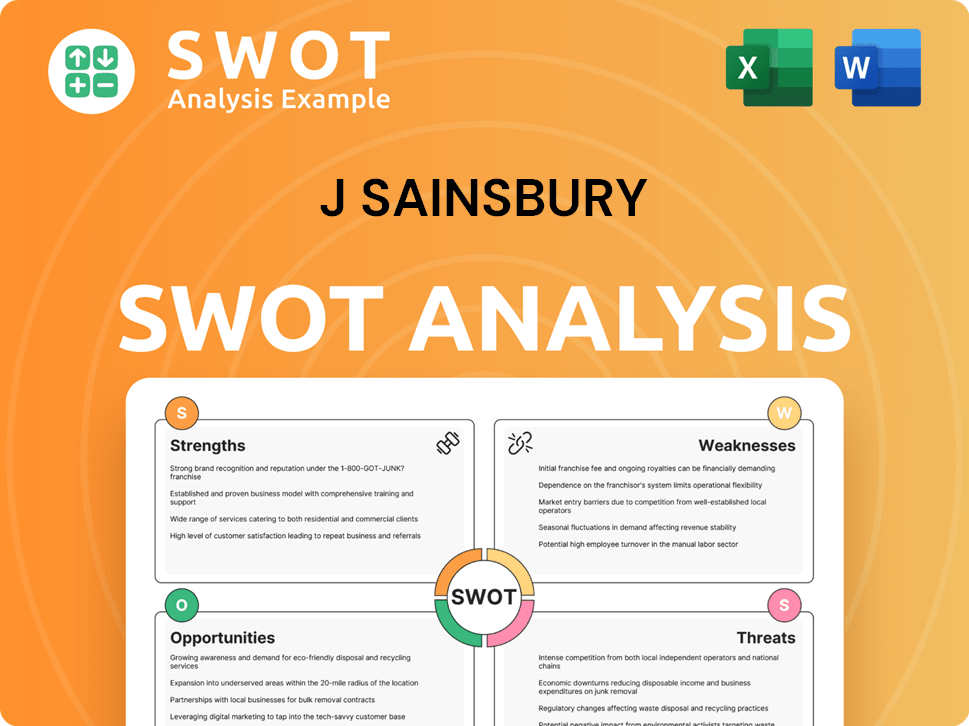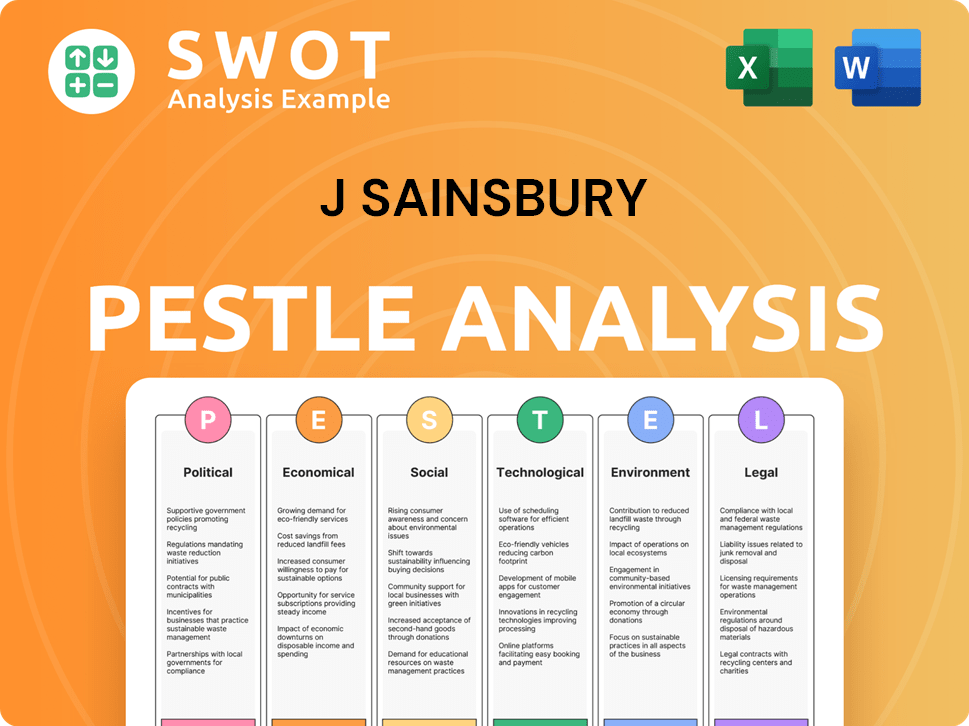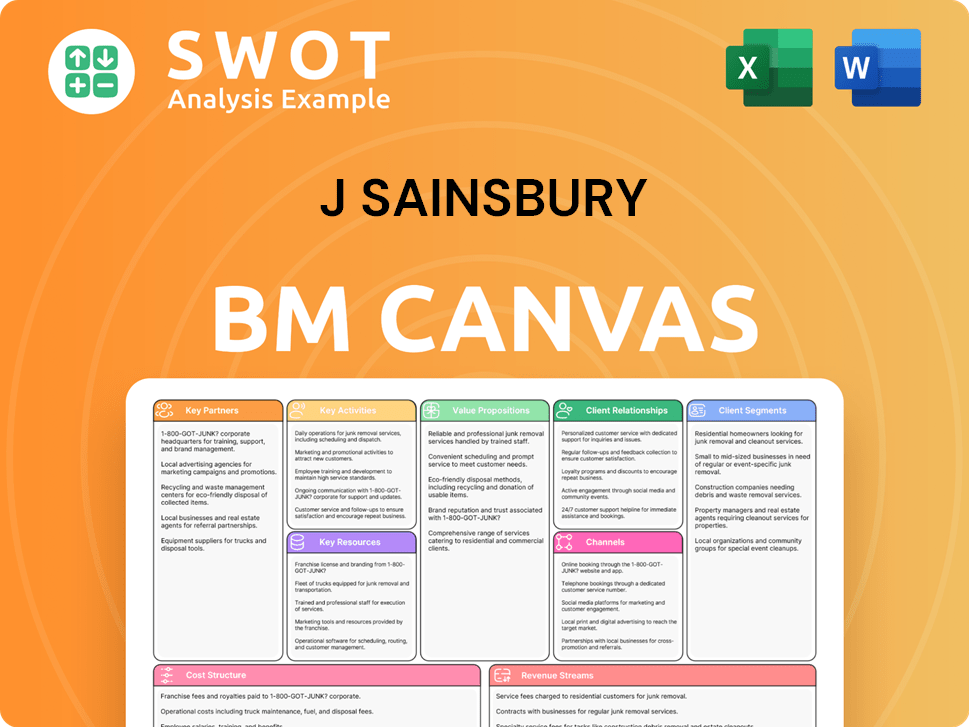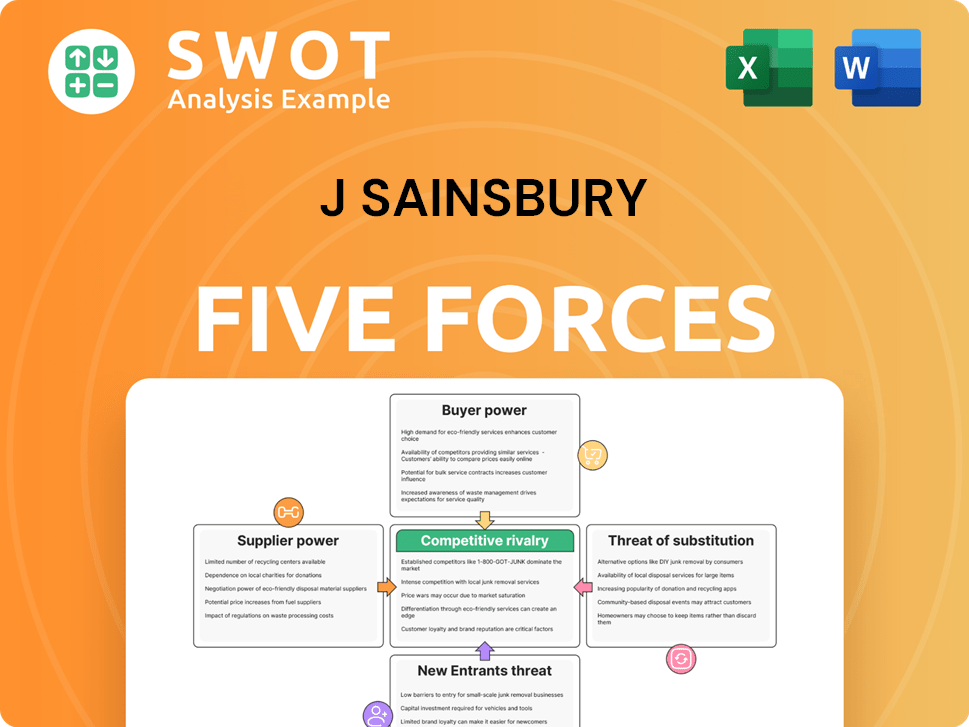J Sainsbury Bundle
Who Buys Groceries at Sainsbury's?
In the dynamic world of retail, understanding your customer is the key to unlocking success. For J Sainsbury, a retail giant with a rich history, pinpointing its J Sainsbury SWOT Analysis is crucial. This exploration dives into the customer demographics and target market that shape Sainsbury's strategic decisions and drive its competitive edge. From its humble beginnings to its current status, Sainsbury's has constantly adapted to meet the evolving needs of its diverse customer base.

This analysis will dissect the Sainsbury's customer profile, exploring factors such as age demographics of Sainsbury's shoppers, Sainsbury's customer income levels, and geographic location of Sainsbury's customers. We'll examine how Sainsbury's utilizes market segmentation to tailor its offerings, considering Sainsbury's customer buying habits and shopping preferences of Sainsbury's customers. Furthermore, we'll assess Sainsbury's target market for online shopping and customer loyalty programs demographics, providing a comprehensive view of who constitutes its target audience.
Who Are J Sainsbury’s Main Customers?
Understanding the customer demographics and target market of J Sainsbury is key to grasping its market position. The company primarily focuses on the consumer market (B2C) within the United Kingdom, operating through supermarkets, convenience stores, and an online platform. This broad approach allows it to serve a wide range of customers, making it a significant player in the UK retail sector.
The J Sainsbury target market spans a wide age range, from 15 to 80 years old, aiming to be a one-stop shop for quality products. This extensive reach is a testament to the company's ability to cater to various needs and preferences. However, a core demographic is the family unit, with a particular focus on mothers as key decision-makers in household grocery shopping. This focus highlights the importance of understanding the needs of families in Sainsbury's marketing strategies.
Sainsbury's positions itself as a mid-to-high-end supermarket, catering to customers who prioritize both quality and value. This strategy is evident in the success of its premium 'Taste the Difference' range, which saw sales growth of 15% in the fiscal year ending March 2025, appearing in one in three baskets and two out of three big shops. This indicates a segment of customers seeking affordable luxury, particularly during economically constrained times. For more insights into Sainsbury's competitive landscape, you can explore the Competitors Landscape of J Sainsbury.
Sainsbury's caters to a broad age range, from 15 to 80 years old. This wide demographic reflects its aim to be a one-stop shop. The company's strategies are designed to appeal to various age groups, ensuring a diverse customer base.
Family units, especially those with children, form a significant part of Sainsbury's customer base. Mothers are often key decision-makers in grocery shopping. The company focuses on family-friendly products and promotions to meet this segment's needs.
Sainsbury's targets customers with mid-to-high income levels. The success of its premium 'Taste the Difference' range, with sales growth of 15%, indicates that customers are willing to pay for quality. This focus helps Sainsbury's maintain a competitive edge.
Customers value both quality and value. The growth in online grocery sales, increasing by 7% year-on-year, demonstrates the increasing preference for convenience. Sainsbury's adapts to these preferences by providing a range of shopping options.
Sainsbury's customer profile is diverse, with a focus on families and those seeking quality. The company's strategies are tailored to meet the needs of various segments, ensuring its continued success. Understanding these segments is crucial for Sainsbury's market strategies and growth.
- The primary target audience includes families and individuals aged 15-80.
- Sainsbury's emphasizes quality and value, reflected in its product ranges.
- The company adapts to changing shopping preferences, including online grocery shopping.
- The 'Food First' strategy has led to 'record market share gains' and an increase in primary customers, with 18% growth in the number of primary customers over the past four years.
J Sainsbury SWOT Analysis
- Complete SWOT Breakdown
- Fully Customizable
- Editable in Excel & Word
- Professional Formatting
- Investor-Ready Format

What Do J Sainsbury’s Customers Want?
Understanding the customer needs and preferences is crucial for any business, and for J Sainsbury, this involves a deep dive into its customer demographics and target market. The company's success hinges on its ability to meet the diverse needs of its customer base, which ranges across various demographics and lifestyle preferences. This includes offering value for money, quality products, and convenient shopping experiences.
The primary drivers for Sainsbury's customers are value, quality, and convenience. These factors influence the shopping behaviors and preferences of a broad spectrum of customers. Sainsbury's continually adapts its strategies to align with the evolving needs of its target audience, ensuring customer satisfaction and loyalty.
Sainsbury's customer profile is shaped by a combination of economic, social, and lifestyle factors. The company focuses on understanding these elements to tailor its offerings and marketing efforts effectively. This customer-centric approach helps Sainsbury's maintain its competitive edge in the retail market.
A key customer need is 'value for money,' which drives purchasing decisions. Sainsbury's has invested significantly in lowering prices to meet this need. The 'Aldi Price Match' program is a direct response to this customer demand.
Customers prioritize quality and freshness, associating the brand with high standards. Sainsbury's emphasizes ethical sourcing and supply chain practices to meet these expectations. The company's commitment to quality is a significant differentiator.
There's a growing customer preference for healthy and sustainable food options. Sainsbury's changed its slogan to 'Helping Everyone Eat Better' in 2021. This shift reflects the company's response to changing consumer preferences.
Convenience is a major factor, with extensive online shopping and home delivery services. Sainsbury's offers personalized experiences through the Nectar loyalty program. This enhances the overall shopping experience.
Personalized experiences through the Nectar loyalty program are crucial. Over 17 million Nectar Digital Collectors regularly shop with Nectar Prices. This helps save customers an average of £12 on a typical £80 weekly shop.
Sainsbury's consistently launches new products to meet market trends and customer feedback. Over 1,300 new products were introduced in the fiscal year ending March 2025. This demonstrates responsiveness to market dynamics.
Sainsbury's has invested £1 billion in lowering prices over the past four years. The 'Aldi Price Match' program has been expanded to include more products. Customer perception of value has improved significantly, up by 8.5 percentage points year-on-year. These initiatives have enhanced customer satisfaction, which is at 'record levels'.
- Customer demographics are diverse, spanning various age groups, income levels, and family sizes.
- J Sainsbury target market includes families, professionals, and individuals seeking value and quality.
- Sainsbury's customer profile is characterized by a preference for convenience, quality, and ethical sourcing.
- Market segmentation is based on factors like price sensitivity, lifestyle, and shopping habits.
- Sainsbury's customer buying habits are influenced by promotions, loyalty programs, and product availability.
- Sainsbury's customer loyalty programs demographics show strong engagement with the Nectar program, driving repeat purchases.
- Sainsbury's target market for online shopping includes busy professionals and those seeking home delivery options.
J Sainsbury PESTLE Analysis
- Covers All 6 PESTLE Categories
- No Research Needed – Save Hours of Work
- Built by Experts, Trusted by Consultants
- Instant Download, Ready to Use
- 100% Editable, Fully Customizable

Where does J Sainsbury operate?
The primary geographical market for J Sainsbury is the United Kingdom. As of December 29, 2024, it operates as the second-largest supermarket chain in the UK, holding a national market share of 16%. This strong presence is supported by an extensive network of over 599 supermarkets and 838 convenience stores across the country.
Sainsbury's also has a significant online presence, with approximately 13% of its grocery revenue generated through its online platform. This demonstrates a robust adaptation to evolving consumer preferences and shopping habits. The company's strategic focus on both physical and digital channels allows it to cater to a broad range of customers and shopping behaviors, thus impacting its customer demographics.
A key aspect of Sainsbury's geographical strategy involves a strong presence in the South-East of England, a region characterized by a more affluent customer base. Despite facing intense competition from rivals like Tesco (with a 28.5% market share) and discounters, Sainsbury's has maintained its market share, gaining ground from other traditional retailers. This strategic positioning and focus on customer demographics helps shape its overall target market.
To succeed in diverse markets, Sainsbury's localizes its offerings and strategies. This includes expanding its convenience store network and introducing 600 new products in these smaller formats. This expansion is a direct response to changing shopping habits and consumer needs.
The company is investing in developing new format stores to better serve specific customer missions, such as its first airport store at Edinburgh airport. This strategic move allows Sainsbury's to reach different segments of its target audience.
In a move to accelerate growth, Sainsbury's acquired 14 new supermarket sites in key target locations from Homebase and Co-op during the fiscal year ending March 2025. The majority are expected to convert and open in 2025/26, representing its largest investment in expanding store space in over a decade.
With approximately 13% of grocery revenue coming from online sales, Sainsbury's demonstrates a strong commitment to its digital presence. This focus helps them cater to a wide range of customers, including those who prefer online shopping, impacting the Marketing Strategy of J Sainsbury.
J Sainsbury Business Model Canvas
- Complete 9-Block Business Model Canvas
- Effortlessly Communicate Your Business Strategy
- Investor-Ready BMC Format
- 100% Editable and Customizable
- Clear and Structured Layout

How Does J Sainsbury Win & Keep Customers?
To acquire and retain customers, Sainsbury's employs a strategy focused on value, quality, and loyalty. The company has invested heavily in lowering prices, aiming to offer a compelling combination of value, quality, and service. This approach has helped Sainsbury's gain market share, with more customers choosing it for their main grocery shopping needs. The 'Aldi Price Match' program is a key component of this strategy, directly addressing competitive pricing concerns.
The Nectar loyalty program plays a crucial role in customer retention. This program has delivered significant savings to customers since its launch. Sainsbury's is enhancing personalization within the Nectar program, leveraging customer data to drive further engagement and profitability. These efforts, combined with improvements in online shopping and delivery services, are designed to boost customer satisfaction and loyalty. This focus on customer acquisition and retention is central to Sainsbury's strategic objectives.
The company also uses a variety of marketing channels. A renewed focus on digital marketing, including increased use of loyalty scheme data, aims to boost more targeted and effective digital marketing. Strong customer service and product availability are key drivers of customer satisfaction and loyalty. The 'Next Level Sainsbury's' strategy, launched in February 2024, continues to prioritize these elements, aiming to deliver further grocery market volume share gains and build a world-leading loyalty platform.
Over the past four years, Sainsbury's has invested £1 billion in lowering prices. This investment has contributed to significant market share gains. The 'Aldi Price Match' program is a key part of this pricing strategy, helping to address competitive pressures.
The Nectar loyalty program is a major customer retention tool. Five million customers reportedly shop with Nectar offers each week. The program has delivered £2 billion in savings to customers since its launch.
Personalization is a key focus for the Nectar program. Sainsbury's aims to generate up to £100 million of incremental profit by March 2027 through the program. This involves leveraging customer data to tailor offers.
A renewed digital push is underway, including the use of loyalty scheme data. This aims to enhance the effectiveness of digital marketing campaigns. Sainsbury's is focused on using digital channels to reach its target audience.
Strong customer service and ensuring product availability are crucial for customer satisfaction. These factors are key drivers of customer loyalty. Sainsbury's prioritizes these elements to maintain a positive customer experience.
- The 'Next Level Sainsbury's' strategy launched in February 2024.
- This strategy aims to deliver further grocery market volume share gains.
- The goal is to build a world-leading loyalty platform.
- Customer satisfaction is a key metric for success.
J Sainsbury Porter's Five Forces Analysis
- Covers All 5 Competitive Forces in Detail
- Structured for Consultants, Students, and Founders
- 100% Editable in Microsoft Word & Excel
- Instant Digital Download – Use Immediately
- Compatible with Mac & PC – Fully Unlocked

Related Blogs
- What are Mission Vision & Core Values of J Sainsbury Company?
- What is Competitive Landscape of J Sainsbury Company?
- What is Growth Strategy and Future Prospects of J Sainsbury Company?
- How Does J Sainsbury Company Work?
- What is Sales and Marketing Strategy of J Sainsbury Company?
- What is Brief History of J Sainsbury Company?
- Who Owns J Sainsbury Company?
Disclaimer
All information, articles, and product details provided on this website are for general informational and educational purposes only. We do not claim any ownership over, nor do we intend to infringe upon, any trademarks, copyrights, logos, brand names, or other intellectual property mentioned or depicted on this site. Such intellectual property remains the property of its respective owners, and any references here are made solely for identification or informational purposes, without implying any affiliation, endorsement, or partnership.
We make no representations or warranties, express or implied, regarding the accuracy, completeness, or suitability of any content or products presented. Nothing on this website should be construed as legal, tax, investment, financial, medical, or other professional advice. In addition, no part of this site—including articles or product references—constitutes a solicitation, recommendation, endorsement, advertisement, or offer to buy or sell any securities, franchises, or other financial instruments, particularly in jurisdictions where such activity would be unlawful.
All content is of a general nature and may not address the specific circumstances of any individual or entity. It is not a substitute for professional advice or services. Any actions you take based on the information provided here are strictly at your own risk. You accept full responsibility for any decisions or outcomes arising from your use of this website and agree to release us from any liability in connection with your use of, or reliance upon, the content or products found herein.